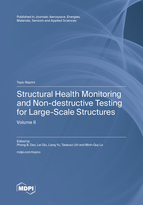Topic Menu
► Topic MenuTopic Editors



Structural Health Monitoring and Non-destructive Testing for Large-Scale Structures

A printed edition is available here.
Topic Information
Dear Colleagues,
Structural health monitoring (SHM) and non-destructive testing (NDT) have gained significant importance for civil, mechanical, aerospace, and offshore structures. Nowadays, we can find SHM and NDT applications being used on various structures with very different requirements. The SHM-NDT field involves a wide range of transdisciplinary areas, including smart materials, embedded sensors and actuators, damage diagnosis and prognosis, signal and image processing, wireless sensor networks, data interpretation, machine learning, data fusion, energy harvesting, etc. Since the 1970s, there has been a large and increasing volume of research on SHM and NDT; a great deal of effort has focused on developing cost-effective, automatic, and reliable damage detection technologies. However, few industrial and commercial applications can be found in the literature. The practical implementation of strategies for the detection of structural damage to real structures outside of laboratory conditions is always one of the most demanding tasks for engineers. One reason for the rare transfer of research into industrial practice is that most of the methods that have been developed have been tested on simple beam and plate structures in the laboratory, while many practical problems only manifest themselves in complex structures. Another reason is the influence of environmental and operational variations (EOVs) on damage-sensitive features. Thus, for the successful development of SHM and NDT for large structures, techniques should be enhanced to have the capability of dealing with the influence of EOVs. In addition, signal/data processing plays an important role in the implementation of SHM and NDT technologies. The processing and interpretation of the massive amount of data generated through the long-term monitoring of large and complex structures (e.g., bridges, buildings, ships, aircrafts, wind turbines, pipes, etc.) has become an emerging challenge that needs to be addressed by the community. This topical collection brings together the most established as well as newly emerging SHM and NDT techniques that can be used for the detection and evaluation of defects and damage development in large-scale or full-scale structures. We cordially invite you to submit your cutting-edge research for consideration. Suitable topics include:
- SHM and NDT for aerospace, civil, mechanical, and offshore infrastructures
- Global monitoring of large structures
- Large-area monitoring for a part/region of a larger structure
- Localised monitoring and damage detection
- SHM and NDT for composite, steel, and concrete structures
- SHM and NDT of bridges, buildings, ships, aircrafts, wind turbines, pipes, and industrial machines
- Novel algorithms for SHM and NDT
- Strategies for the removal of EOVs for SHM and NDT
- Advanced signal processing for SHM and NDT
- Artificial intelligence and machine learning for SHM and NDT
- Time series analysis and statistical approaches for SHM and NDT
- Damage detection, diagnosis, and prognosis
Dr. Phong B. Dao
Prof. Dr. Lei Qiu
Dr. Liang Yu
Prof. Dr. Tadeusz Uhl
Prof. Dr. Minh-Quy Le
Topic Editors
Keywords
- structural health monitoring
- non-destructive testing
- condition monitoring
- damage detection
- remaining useful life prediction
- smart materials and structures
- embedded sensors and actuators
- composite structures
- steel structures
- reinforced concrete structures
- ultrasonic testing
- laser vibrometry
- infrared thermography
- terahertz testing
- thermal and hyperspectral imaging
Participating Journals
| Journal Name | Impact Factor | CiteScore | Launched Year | First Decision (median) | APC |
|---|---|---|---|---|---|

Aerospace
|
2.6 | 3.0 | 2014 | 22.3 Days | CHF 2400 |

Energies
|
3.2 | 5.5 | 2008 | 16.1 Days | CHF 2600 |

Materials
|
3.4 | 5.2 | 2008 | 13.9 Days | CHF 2600 |

Sensors
|
3.9 | 6.8 | 2001 | 17 Days | CHF 2600 |

Applied Sciences
|
2.7 | 4.5 | 2011 | 16.9 Days | CHF 2400 |

MDPI Topics is cooperating with Preprints.org and has built a direct connection between MDPI journals and Preprints.org. Authors are encouraged to enjoy the benefits by posting a preprint at Preprints.org prior to publication:
- Immediately share your ideas ahead of publication and establish your research priority;
- Protect your idea from being stolen with this time-stamped preprint article;
- Enhance the exposure and impact of your research;
- Receive feedback from your peers in advance;
- Have it indexed in Web of Science (Preprint Citation Index), Google Scholar, Crossref, SHARE, PrePubMed, Scilit and Europe PMC.


